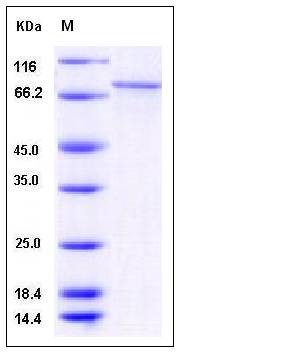Human CAMK1G / CLICK III / CaMKIgamma Protein (His & GST Tag)
CLICK3,CLICKIII,dJ272L16.1,VWS1
- 100ug (NPP3631) Please inquiry
| Catalog Number | P13148-H20B |
|---|---|
| Organism Species | Human |
| Host | Baculovirus-Insect Cells |
| Synonyms | CLICK3,CLICKIII,dJ272L16.1,VWS1 |
| Molecular Weight | The recombinant human CAMK1G/GST chimera consists of 713 amino acids and has a calculated molecular mass of 81 kDa. It migrates as an approximately 75 kDa band in SDS-PAGE under reducing conditions. |
| predicted N | Met |
| SDS-PAGE |  |
| Purity | > 85 % as determined by SDS-PAGE |
| Protein Construction | A DNA sequence encoding the human CAMK1G isoform 1 (Q96NX5-1) (Met 1-Met 476) was fused with the N-terminal polyhistidine-tagged GST tag at the N-terminus. |
| Bio-activity | No Kinase Activity |
| Research Area | Neuroscience |Neurotransmission |Calcium Signaling |Calmodulin Pathway |
| Formulation | Supplied as sterile 50mM Tris, 100mM NaCl, pH 8.0, 20% gly, 0.3mM DTT 1. Normally 5 % - 8 % trehalose and mannitol are added as protectants before lyophilization. Specific concentrations are included in the hardcopy of COA. |
| Background | Calmodulin-Dependent Protein Kinase (CaM Kinase) is a kind of protein phosphorylate multiple downstream targets. Concentration of cytosolic calcium functions as a second messenger that mediates a wide range of cellular responses. Calcium binds to calcium binding proteins (calmodulin/CaM) and stimulates the activity of a variety of enzymes, including CaM kinases referred to as CaM-kinases (CaMKs), such as CaMKI, CaMKII, CaMKIV and CaMKK. Calmodulin-dependent protein kinase CL3/CaMKIγ is a memberane-anchored CaMK belonging to the CaM kinase family. Its C-terminal region is uniquely modified by two sequential lipidification steps: prenylation followed by a kinase-activity-regulated palmitoylation. These modifications are essential for CaMKIγ membrane anchoring and targeting into detergent-resistant lipid microdomains in the dendrites. It has been found that CaMKIγ critically contributed to BDNF-stimulated dendritic growth. Raft insertion of CaMKIγ specifically promoted dendritogenesis of cortical neurons by acting upstream of RacGEF STEF and Rac, both present in lipid rafts. Thus, CaMKIγ may represent a key element in the Ca2+-dependent and lipid-raft-delineated switch that turns on extrinsic activity-regulated dendrite formation in developing cortical neurons. |
| Reference |
